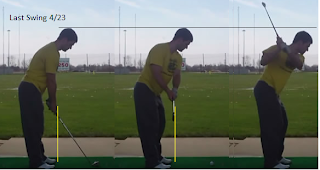Yesterday, I spoke with Gorillaswing while he was in the middle of his practice session. Asking Gorilla’ “what are you working on” he replied:
“…my setup and takeaway, I started hitting balls using the setup drill you gave me**and now I am setting up normal and checking to make sure I can take it to the course…I started hitting some squirrelly shots but then I felt my hands coming over the top… so now I am trying to pull my hands straight down….”
How do you know when you are done practicing?
“I don’t know. When I am tired?”
Two weeks prior to this practice session Gorilla’s and I worked together and focused on cleaning up his takeaway (the results of this practice are available on this blog). As his coach I know that getting to a more conventional takeaway position will change all the following positions and the timing or his golf swing; which are both expected and desired, despite his minds desire to recreate the old positions. Assuming he was able to change his takeaway in this practice session it is no surprise that he would begin to feel an “over the top” move because he is an OTT player (over the top of the plane line). With a conventional takeaway he can now feel that he is not swinging through the plane he has set in the takeaway. Identifying the feel is instrumental in changing from an inefficient swing pattern; however, Gorilla’s err was attempting to a new fix to this feeling. What I would have like the G’man to do is to only focus on a proper takeaway. Like the snowmelt that eroded the Arizona desert into the Grand Canyon, persistent repetition of a proper takeaway will reshape Gorillaswing’s backswing, transition, and recoil without the need to add new swing thoughts.
The question now becomes how do you continue to practice when the shot shape looks so poor and impact isn’t feeling great. First you must determine if you are indeed recreating the corrected move when over the ball? In this example the desired takeaway position. There are only a few ways to be sure: video, a trusted friends eye, or a drill. Odds are if impact isn’t improving you are missing your new position/s or you are reaching the new position but your mind is compensating with the old swing. If the former, then you must simplify the practice to only work on the desire position. In this case Gorilla should have abandoned full swings and only hit ¾ shots - swing back until his lead arm was at 9 o’clock / parallel to the ground.

Gorilla Try this drill and let us know how it works
PPMS
This message is private and confidential. If you have received it in error, please notify the sender and remove it from your system.





